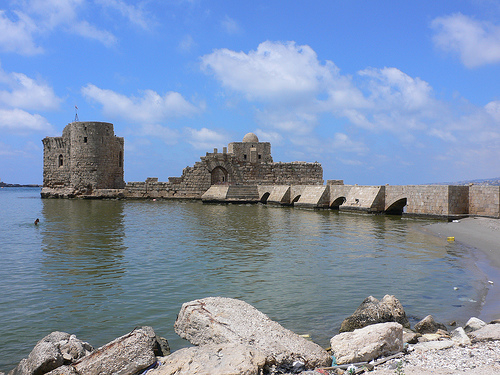

Location: Sidon, South Governorate Map
Constructed: 1228 by Crusaders
Sidon Sea Castle is a medieval fortress situated on a island and connected to the mainland via a 80 meter causeway. It is located in the city of Sidon of the South Governorate in Lebanon. Sidon Sea Castle was constructed in 1228 by the Crusaders on ruins of Phoenician temple devoted to Melkart. This mythical hero distinguished himself with numerous feats of bravery and chivalry. After his death he was proclaimed a deity and several shrines were devoted to him in the Eastern Mediterranean. Romans established their own fortification here, but it was largely in ruins by the time Christian armies of Western Europe showed up here. The castle protected local harbor from attacks of the pirates. After Crusaders lost control of the region the walls of the their former stronghold was largely destroyed by the Mamluks. In the following centuries Muslims did rebuild several of the towers to keep an eye over the watery frontier, but it did not reach the same level of sophistication as it did in the Medieval times.
The Sidonian Sea Fortress is the ruins of a 13th-century
fortification that once protected the city from raids. Historians
have proven that most of the fortress was built by the Crusaders
around 1228 as a defensive structure. The castle was built on a
small island, which is connected to the mainland by an 80-meter
stone isthmus.
The fortress owes its name to the city of
Sidon, in which it is located. In Ancient Phenicia, the coast was
not flooded like it is today. According to some chronicles, it can
be assumed that the first building on the island was the palace of
the Phoenician king, destroyed in the war with Assyria and the
subsequent earthquake.
Research by scientists has shown that
there was also a Greco-Roman temple of Hercules (Melkart) on this
site. Later, its columns were used by the Crusaders to horizontally
strengthen the superstructures of the old foundation. The first
serious destruction in the Sidonian fortress appeared after the
capture of the city by the Mamluks, who rebuilt much of the castle
and the city itself. The dam itself is also the result of their
work. In the 17th century, the restoration of the fort was carried
out under the reign of Emir Fakhr ad-Din II.
Nowadays, the
island castle of the Crusaders is the calling card of the city. It
is worth noting that on a hill nearby is the Castle of St. Louis,
which is sometimes mistakenly also called the Sidonian Fortress. In
order not to confuse two different attractions, the fort on the
island began to be called a sea fort.
The modern appearance of the Sidonian fortress is two preserved
towers connected by a thick wall. Above the entrance to the fort,
medieval decorations in the form of figurines of animals and people have
been preserved. The most outstanding fragment of the ancient fort is
considered to be the powerful Western Tower. It is located to the left
of the entrance to the castle and is in much better condition.
Inside the tower there is a large knight's hall (more than 50 m in
length), the vaults of which are built in the form of an arch, as was
customary in the Middle Ages. Inside, elements of capitals and even
cannonballs rusted from time to time were preserved. The second tier of
the tower was built during the period of domination of the Ottoman
Empire. There is a mosque here, and from the roof, reached by a stone
spiral staircase, there is an excellent view of the harbor and the old
city. Similar stairs go through the thickness of the defensive wall into
the basements of the Sidonian fortress.
The eastern tower is
somewhat worse preserved; it is located to the right of the entrance.
Its upper tier was completed by the Mamluks. In this side, artifacts of
an ancient Phoenician city, currently flooded, are also well preserved.
These are statues, small towers, ruins of buildings, fragments of
columns and walls.
You can visit the Sidon Fortress any day from 9 a.m. to 6 p.m.; it is
open even on weekends and holidays. For the safety of visitors, the
undestroyed rooms of the Western Tower, all recesses and basements are
closed with bars.
The most convenient way to get to the dam is by
taxi. Entrance to the fortress territory is nominally paid, but no
additional payment is required for photo and video filming.
Time
for inspection or excursion is about 30-40 minutes.